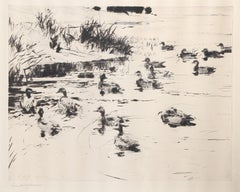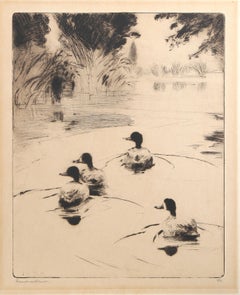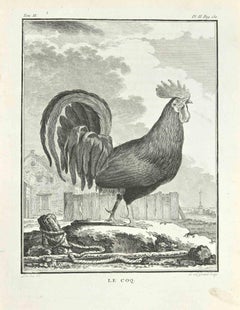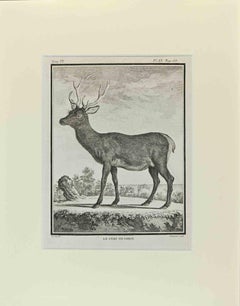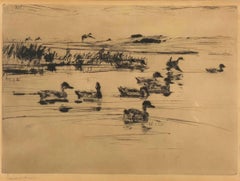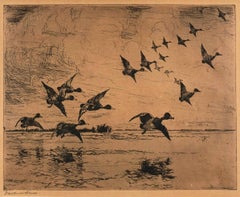Frank Weston Benson Animal Prints
to
2
Overall Width
to
Overall Height
to
2
7
196
162
104
101
2
1
1
1
1
2
2
1
1
1
1
1
2
2
Artist: Frank Weston Benson
Ducks on Lake, Signed Modern Etching by Frank Weston Benson
By Frank Weston Benson
Located in Long Island City, NY
Ducks on Lake
Frank Weston Benson, American (1862–1951)
Date: 1923
Etching on thin wove paper, signed in pencil and dated in the plate
Image Size: 11 x 14 inches
Size: 14 x 16.5 in. ...
Category
1920s Modern Frank Weston Benson Animal Prints
Materials
Etching
Ducks at Play, Signed Modern Etching Mounted to Board by Frank Weston Benson
By Frank Weston Benson
Located in Long Island City, NY
Ducks at Play
Frank Weston Benson, American (1862–1951)
Date: 1940
Etching mounted to board, signed and dated in pencil
Image Size: 10 x 8 inches
Size: 12 x 10 in. (30.48 x 25.4 cm)
Category
1940s Modern Frank Weston Benson Animal Prints
Materials
Etching
Related Items
Le Coq - Etching by Louis Legrand - 1771
By Louis Legrand
Located in Roma, IT
Le Coq is an etching realized in 1771 by Louis Legrand (1723-1807).
Titled and Signed on the plate.
The artwork Belongs to the suite "Histoire naturelle, générale et particulière a...
Category
1770s Modern Frank Weston Benson Animal Prints
Materials
Etching
Le Cerf De Corse - Etching by Buvée l'Américain - 1771
Located in Roma, IT
Le Cerf De Corse is an artwork realized by Buvée l'Américain in 1771.
Etching B./W. print on ivory paper.
The artwork belongs to the suite "Histoire naturelle, générale et par...
Category
1770s Modern Frank Weston Benson Animal Prints
Materials
Etching
$178
H 8.67 in W 6.7 in D 0.04 in
Interior of Animals - Etching by Marcel Gaillard - 1771
Located in Roma, IT
Interior of Animals is an etching realized by Marcel Gaillard in 1771.
The artwork Belongs to the suite "Histoire naturelle, générale et particulière avec la description du Cabinet ...
Category
1770s Modern Frank Weston Benson Animal Prints
Materials
Etching
$237
H 9.45 in W 7.88 in D 0.04 in
The Cat - Original Etching by Giselle Halff - 1950s
By Giselle Halff
Located in Roma, IT
The Cat is an Original etching print on paper realized by Giselle Halff in 1950 ca.
Good conditions with some foxing.
.
Category
1950s Modern Frank Weston Benson Animal Prints
Materials
Etching
$401
H 7.49 in W 11.03 in D 0.04 in
Birds - Etching by Robert De Launay - 1771
By Robert De Launay
Located in Roma, IT
Birds is an etching realized in 1771 by Robert De Launay.
The Artwork is depicted through confident strokes in aa well balanced composition.
Good conditions.
Category
1770s Modern Frank Weston Benson Animal Prints
Materials
Etching
Anatomy of Animals - Etching by René Gaillard - 1771
Located in Roma, IT
Anatomy of Animals is an etching realized in 1771 by René Gaillard.
It belongs to the suite "Histoire naturelle, générale et particulière avec la description du Cabinet du Roi".
Ar...
Category
1770s Modern Frank Weston Benson Animal Prints
Materials
Etching
$213
H 9.45 in W 7.88 in D 0.04 in
Insects - Etching by Sergio Barletta - 1974
By Sergio Barletta
Located in Roma, IT
Insects is an etching realized by Sergio Barletta in 1974.
Hand-signed in pencil on the lower right. Numbered on the lower left in Roman numerals, from the edition of XXX prints.
...
Category
1970s Modern Frank Weston Benson Animal Prints
Materials
Etching
Le Surikate - Etching by Jean Charles Baquoy - 1771
Located in Roma, IT
Le Surikate is an etching realized by Jean Charles Baquoy in 1771.
The artwork Belongs to the suite "Histoire naturelle, générale et particulière avec la description du Cabinet du R...
Category
1770s Modern Frank Weston Benson Animal Prints
Materials
Etching
$237
H 9.85 in W 7.49 in D 0.04 in
Le de Forte Race - Etching by Jean Charles Baquoy - 1771
Located in Roma, IT
Interior of an Animal is an etching realized in 1771.
The artwork Belongs to the suite "Histoire naturelle, générale et particulière avec la description du Cabinet du Roi". Paris: I...
Category
1770s Modern Frank Weston Benson Animal Prints
Materials
Etching
$237
H 9.45 in W 7.88 in D 0.04 in
Anatomy of Animals - Etching by Louis Legrand - 1771
By Louis Legrand
Located in Roma, IT
Anatomy of Animals is an etching realized in 1771 by Louis Legrand (1723-1807).
It belongs to the suite "Histoire naturelle, générale et particulière avec la description du Cabinet ...
Category
1770s Modern Frank Weston Benson Animal Prints
Materials
Etching
$237
H 9.45 in W 7.88 in D 0.08 in
L'Oreillar - Etching by Jean Charles Baquoy - 1771
Located in Roma, IT
L'Oreillar is an etching realized by Jean Charles Baquoy in 1771.
It belongs to the suite "Histoire Naturelle de Buffon".
The Artist's signature is engraved lower right.
Good cond...
Category
1770s Modern Frank Weston Benson Animal Prints
Materials
Etching
$237
H 9.85 in W 7.49 in D 0.04 in
Composition with Angels - Etching by Antoine Defehrt - 1771
Located in Roma, IT
Composition with Animals is an etching realized by Antoine Defehrt in 1771.
It belongs to the suite "Histoire naturelle, générale et particulière avec la description du Cabinet du R...
Category
1770s Modern Frank Weston Benson Animal Prints
Materials
Etching
$190
H 3.55 in W 5.52 in D 0.08 in
Previously Available Items
Teal
By Frank Weston Benson
Located in Missouri, MO
Frank Weston Benson (1862-1951)
"Teal" 1925 (Paff 243)
Etching
Ed. 150
Signed Lower Left
Image Size: approx 8 x 10 inches
Framed Size: approx 14.5 x 16 inches
Born in Salem, Massac...
Category
1920s American Realist Frank Weston Benson Animal Prints
Materials
Etching
The Alarm
By Frank Weston Benson
Located in Missouri, MO
Frank Weston Benson (1862-1951)
"The Alarm" 1917
Etching
Ed. 80
Signed Lower Right
Image Size: approx 8 x 10 inches
Framed Size: approx 14.5 x 16 inches
Born in Salem, Massachusett...
Category
1910s Realist Frank Weston Benson Animal Prints
Materials
Etching
Geese.
By Frank Weston Benson
Located in Storrs, CT
Geese. 1917. Drypoint. Paff 124. 10 x 15 1/2 (sheet 13 3/16 x 17 3/4). Trial proof, before the edition of 79 proofs in 4 states. Illustrated: Salaman, Modern Masters of Etching: Fran...
Category
1910s American Modern Frank Weston Benson Animal Prints
Materials
Drypoint
Mallards
By Frank Weston Benson
Located in Storrs, CT
Mallards at Evening 1927. Drypoint. Paff 271. 13 7/8 x 11 7/8 (sheet 15 7/8 C 13 4/5). Edition 112. An extremely rich impression with drypoint burr, printed on the full sheet of crea...
Category
1920s Modern Frank Weston Benson Animal Prints
Materials
Drypoint
Frank Weston Benson animal prints for sale on 1stDibs.
Find a wide variety of authentic Frank Weston Benson animal prints available for sale on 1stDibs. Customers who are interested in this artist might also find the work of Zack Seckler, David Gilhooly, and Michael Knigin.
